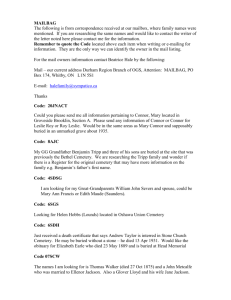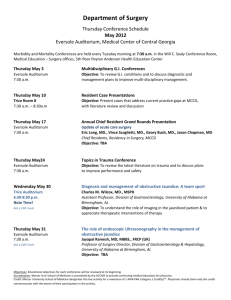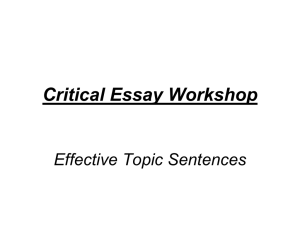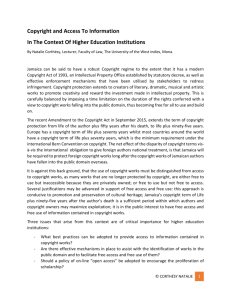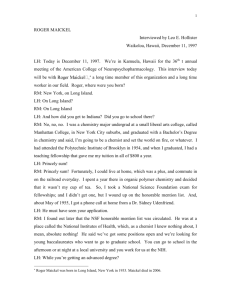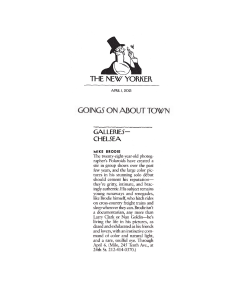in Community Development - Politics and Government| Illinois State
advertisement
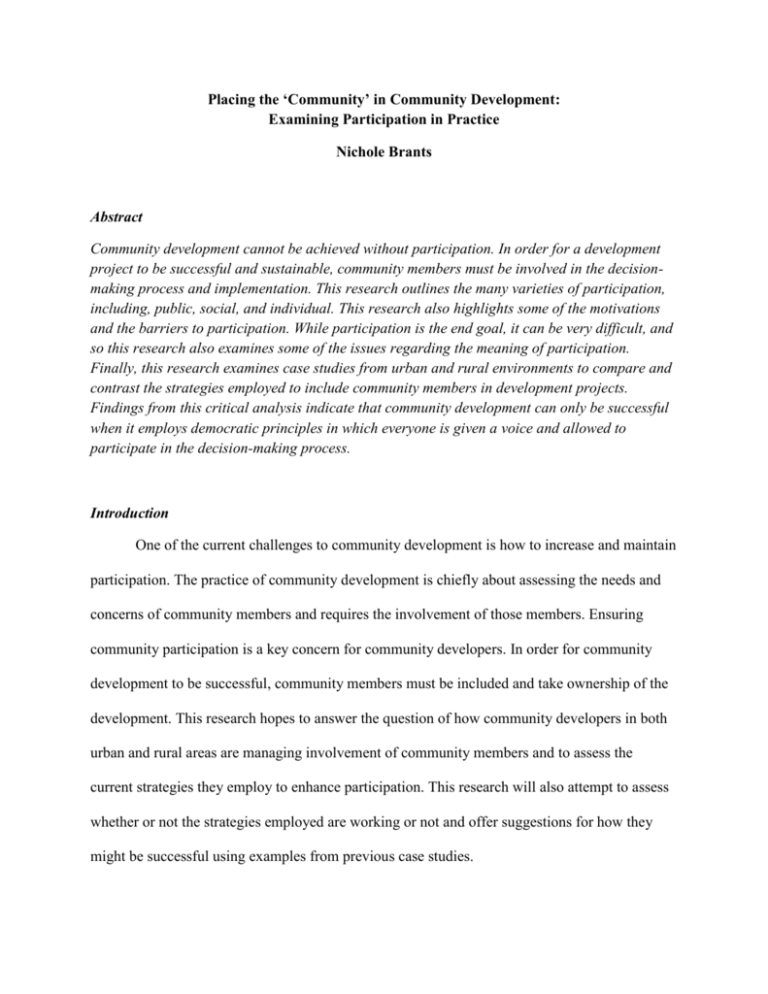
Placing the ‘Community’ in Community Development: Examining Participation in Practice Nichole Brants Abstract Community development cannot be achieved without participation. In order for a development project to be successful and sustainable, community members must be involved in the decisionmaking process and implementation. This research outlines the many varieties of participation, including, public, social, and individual. This research also highlights some of the motivations and the barriers to participation. While participation is the end goal, it can be very difficult, and so this research also examines some of the issues regarding the meaning of participation. Finally, this research examines case studies from urban and rural environments to compare and contrast the strategies employed to include community members in development projects. Findings from this critical analysis indicate that community development can only be successful when it employs democratic principles in which everyone is given a voice and allowed to participate in the decision-making process. Introduction One of the current challenges to community development is how to increase and maintain participation. The practice of community development is chiefly about assessing the needs and concerns of community members and requires the involvement of those members. Ensuring community participation is a key concern for community developers. In order for community development to be successful, community members must be included and take ownership of the development. This research hopes to answer the question of how community developers in both urban and rural areas are managing involvement of community members and to assess the current strategies they employ to enhance participation. This research will also attempt to assess whether or not the strategies employed are working or not and offer suggestions for how they might be successful using examples from previous case studies. Page |2 In an ever-increasing global society, the term “community” has many definitions that range from geographic proximity to shared ideals. Strategies for participation might vary greatly between a community of space and a virtual community. The readings examined herein discuss the need for participation, but what does participation mean in a globalized context? How do different organizations define participation and how do they form that definition into action? Eversole (2012) uses the example of World Bank’s emphasis on maintaining the status quo by rearranging the poor within the prevailing system, which assumes that development is created by formal agencies of development. Participation is meant to be a bottom-up solution, but how is it achieved? How is participation maintained? And why is participation an “elusive goal” (Eversole 2012)? Using case studies from both urban and rural community development projects, I hope to examine participation approaches and determine common themes for success. I also hope to account for why these case studies are successful and if not, attempt to determine how they might become successful. This paper will be theoretical research and the method of collection will be through the use of case studies from scholarly articles or books that examine participation in community development. Community Development Community development can be defined in many ways, but Vincent (2009) describes it as a process “whereby all citizens are involved in the process of community change and improvement” (58). This definition highlights the practice of community development as a people-centered process. Remenyi (2004) also notes that development is a process and an outcome. Remenyi (2004) also states that development is a “process of growth towards self- Page |3 reliance and contentment” (25). As an outcome, the development is meant to alleviate problems and empower community members. Community development gained popularity in the 1960s with the introduction of government programs aimed at alleviating poverty and placed a great emphasis on public participation as a means to an end (Taylor 1995). By the 1980s, the state began to retreat from providing public services, designating community development to a lower place on the government agenda. This allowed some community organizations to become ‘agents’ of the state in order to provide services (Humm et al. 2005). In the 1990s, there was a similar interest in sustainable development, which followed the adoption of Agenda 21 by the United Nations.1 Brodie et al. (2009) discuss this concept of sustainable development, which lead to the flimsy links between “global issues of environmentalism, international development to tackle poverty, economic development, and social change through greater participation in governance being strengthened and institutionalized at local, national and international levels” (8). These new relationships formed the basis for creating spaces for participation on various issues from global poverty to climate change (Brodie et al. 2009). What is Community? It is important to note that community is not necessarily defined by geographical or legal boundaries. Vincent (2009) discusses that a community could “involve interaction among people with common interests who live in a particular area” or regardless of residency, a collection of people with shared interests (58). Bartle (2003) notes that community, as a concept, is a social 1 Agenda 21 is grouped into four sections which examine the social and economic dimensions, the conservation and management of resources, strengthening the role of major groups, and the means of implementation. The social and economic dimensions are directed toward international cooperation in combating poverty and promoting health, among other things. Strengthening the role of major groups was meant to include women and children, as well as communities and indigenous people (United Nations 1992). Page |4 construct, not necessarily a tangible location. Instead, community can be a common interest among people. Bartle (2003) also notes that a community is a “set of interactions, human behaviors that have meaning and expectations between its members” (2). The actions that come of this type of community are based on shared values and expectations. Communities do not have clear boundaries. There may even be communities within larger communities. Bartle (2003) remarks that the larger the boundaries of a community, the more heterogeneity in that community. To borrow the insights of Durkheim, one could refer to mechanical vs. organic societies. A mechanical society is one that is small, simple, homogeneous, and largely based on moral values. An organic society is more complex and heterogeneous. Theory There are a variety of theories that help us understand various approaches to community development and the reasons behind why some people participate in a variety of activities. Theory is helpful in our understanding of power dynamics regarding community development and participation. Theories also help to shed light on the varied reasons of participation or lack thereof. One theory that is concerned with relationships is social capital theory. Hustedde (2009) defines social capital as a set of “resources intrinsic to social relations and includes trust, norms, and networks” (22). Hustedde also highlights that social capital is often connected to civic engagement and overall community well-being. This is identical to Putnam’s (1993) notion of social capital, which drew on de Tocqueville’s interest in civil society and voluntary associations. Putnam (1993) posits that participating in local organizations helps to foster trust in others and a sense of shared values. Page |5 While social capital is a popular concept and theory, it is not without its critics. One reason for this could be the multitude of definitions. Bourdieu’s (1983) conception of social capital was an attempt to understand the production of classes and class divisions and is chiefly about power relations. Coleman (1988) views social capital as a variety of entities that consist of a social structure which enables actions of agents within that structure. These views of social capital are very different from that of Putnam, who views it as a resource. Another criticism of social capital is that it is difficult to “establish the causal links between associational life, high social trust, and better government” (Brodie et al. 2009, 35). If social capital is viewed in the sense of Bourdieu’s notion of power relations, then it merely serves to benefit those who are already privileged. Another theory which is vital to understanding community development is conflict theory, which is chiefly concerned with power. In this context, power refers to the control of resources which are necessary for development. These resources can be land, labor, capital, or even knowledge. Hustedde (2009) states that if community developers want to build capacity, they must understand conflict theory because the development occurs within existing power structures and the developers need be aware of the power struggles that exist in daily life. In order to manage community involvement, practitioners must be able to weave their way through the power structures and be able to communicate with both the powerful and powerless. Lastly, the theory of functionalism is also important towards understanding community development. Functionalism is primarily concerned with structures. With this theory, community developers hope to understand the structure or the underlying organizations and groups that could help to bring about or resist change. This theory helps practitioners navigate some of the barriers to participation within society by examining the structures. Page |6 What is Participation? Participation can be as difficult to define as that of community development. Gwaba (2003) translates participation from one of the Zambian languages as “to be part of or to give oneself to what is going on” (88). Participation can mean a variety of things; a review of Brodie et al. (2009) revealed three categories of participation. The first was termed ‘vertical participation’ or public, whereby individuals engage with the state and governmental institutions; an example of this type of participation can include voting. The second is ‘horizontal participation’ or social, which refers to the collective actions that individuals engage in, such as being part of a community group. The last is ‘everyday politics’ or individual, which refers to the day-to-day choices people make regarding what kind of society they want to live in, such as buying fair-trade goods or supporting worthy causes. Participation is a bit of a buzzword for development practitioners. Brodie et al (2009) highlight several reasons behind this emphasis on participation. One being that participation can strengthen or legitimize government institutions by involving people in the decision-making process. Another reason is that communities can be empowered when people are allowed to contribute to local decisions. A third reason is that participation can bring about services geared towards what people actually need or want. Lastly and similar to the previous, there are certain benefits that can come from participation, including increased self-esteem or satisfaction from knowing they had an influence on policy changes. Public Participation Public participation or ‘vertical’ refers to how engaged individuals are with the various structures and governmental institutions. This form of participation can also be referred to as ‘political participation’ (Brodie et al. 2009). Burns et al. (2004) explains that participation Page |7 “concerns the engagement of individuals and communities in decisions about things that affect their lives” (2). Within community development, this form of participation emphasizes engaging individuals and/or communities with local institutions and political structures. This leads to a focus on capacity-building of individuals, organizations, and communities to effectively promote involvement (Brodie et al. 2009). The underlying theme is that a partnership between government and community works the best because neither one by themselves can solve everything. Social Participation Social participation refers to the collective actions that individuals engage in as participants. Social participation, “the associations people form between and for themselves,” include informal contexts of self-help and solidarity, mutual aid, and more formal contexts as well (Brodie et al. 2009, 7; Gilchrist 2004). The motivations to get involved in these associations are generally based on an individual’s faith, values, or even a sense of community. Community development that involves this type of participation would largely focus on community organizing and service delivery. Social participation follows similar lines as de Tocqueville with the importance of associations and shared interests, purposes, and values. Putnam (1993) says that this type of participation encourages ‘social capital’ and connects people based on shared norms. Social participation can increase confidence and Brodie et al. (2009) state that most importantly, “humans enjoy being connected – it is a major determinant of well-being” (7). However, the positive aspects cannot be overstated. Field (2003) highlights a number of dangers or cautions to this notion of social participation as a normative ‘good thing.’ Putnam (1993) states that participation can be exclusionary and not necessarily lead to a ‘social good.’ Page |8 Examples of this could include extremist groups working towards nefarious ends (Carothers 2000). Individual Participation Last, is individual participation, which refers to the day-to-day choices people make regarding what kind of society they want to live in. This type of participation is based on personal values as well as personal experiences or identities (Brodie et al. 2009). Individuals may choose to donate to charity or buy fair-trade products; in essence this form of participation involves the personal choices that people make in everyday life. Ginsborg (2005) also highlights that individuals can also be inspired to make connections between their own lives and the larger forces in the globalized world. Connections These forms of participation often overlap with one another. There are many ways in which these forms can connect to one another. For the most part, this discussion has highlighted the notion that participation is a fluid concept with indistinct boundaries between the different forms. Participation is best understood as a democratic concept, where citizens are allowed to express interest or concern in political decisions. The various forms of participation also highlight the unequal distribution of power and resources within society. Participation can only be understood when observing the wider context of society and explore reasons why some individuals do not participate or are otherwise prevented from participating (Brodie et al. 2009). To understand the broader concept of participation, Arnstein (1969) created a ladder of participation (Table 1) to address the different depths of participation. For this understanding, she asked the question of what citizen participation is and how it relates to social imperatives. Arnstein argues that public participation is actually on the lower rungs of the ladder (Cornwall Page |9 2008). The best form of participation is clearly at the top, when citizens are in control or at least featured as partners in decisions. Table 1: Arnstein’s (1969) Ladder of Participation Citizen Control Delegated Power Partnership Placation Consultation Informing Therapy Manipulation Degrees of Citizen Power Degrees of Tokenism Non-Participation (Arnstein, Sherry. 1969. A Ladder of Citizen Participation.) However, this ladder also has critics who ask what control means, who the citizens are, and why they would seek this form of power. White (1996) created a new chart (Table 2), which explored the various interests in participation. Brodie et al (2009) explain that this table “helps to identify where and under which circumstances different forms of participation can create either opportunities for participation or entrench and reproduce existing power relations” (19). White’s model of participation highlights change over time and theorizes participation as a site of contestation and conflict. White (1996) also states that “sharing through participation does not necessarily mean sharing in power” (6). Table 2: White’s (1996) typology of participation Form What is the level of participation? Nominal Instrumental Representative Transformative Top-Down What’s in it for government or associated agencies? Legitimation Efficiency Sustainability Empowerment Bottom-Up What’s in it for individuals and communities? Inclusion Cost Leverage Empowerment (White, S.C. 1996. Depoliticizing Development: The Uses and Abuses of Participation.) Function What is participation for? Display Means Voice Means/End P a g e | 10 Motivations or Barriers to Participation There have been many studies that attempt to understand the motivations or deterrents that individuals face in regards to participation. Along with personal motivations, there are a number of factors that allow and encourage people to participate and can be used to explain why some people choose to get involved or discontinue their participation. Brodie et al (2009) highlight some factors like financial circumstance, socio-demographics, or other life events may contribute. Personal motivations may be in regards to individual values and beliefs. The factors that contribute to active participation are varied. Studies from Lowndes (2001) have shown that being invited to participate can be a great motivator. Bartle (2003) refers to a specific person as a social animator, one who attempts to motivate and organize a community into action through their knowledge of existing networks in the community. There are also various deterrents that stand to prevent individuals from participating. These barriers can include institutional factors, whether through government or voluntary organizations, that seem to be overly bureaucratic, complex, and intimidating to outsiders (Brodie et al 2009). Personal deterrents may also be caused by a lack of resources. Musick and Wilson (2008) highlight that education can be a predictor of participation, stating that “the more education people have the more extensive and heterogeneous are their social networks, which increases the chance they will be asked” (120). A lack of education could also cause individuals to feel intimidated and therefore prevent them from participating. A lack of financial resources may also be considered a barrier. Along with lack of finances, Musick and Wilson (2008) highlight a lack of time and poor health can also contribute to nonparticipation. Finally, a lack of knowledge about activities and how to get involved also act as barriers to involvement. The barriers cited above often act together. For example a lack of education or awareness of the issues will prevent people from participating. These barriers do not necessarily stand to P a g e | 11 keep people from participating in the first place, but could potentially change the participation, which is why knowledge of how participation is sustained is important. Sustaining participation Knowing why individuals continue to participate is just as important as understanding the initial motivations for participation. The concept of continued participation is very similar to some of the deterrents. For example, the personal factors of stability, education, and personal values are important features for continuation (Locke et al. 2003). Klandermans (2004) also stipulates that lack of gratification or concrete results from action along with lessening commitment are strong predictors of withdrawal. Participants are more likely to continue their involvement if they are emotionally attached to the cause. Emotions like frustration and anger often provide the impetus for involvement but are unlikely to sustain a movement. Passy and Giugni (2000) argue that once participants have connected the cause to the three main life spheres of “family, studies, and work,” then their involvement will be strengthened and “the higher the chances that such an issue will become a crucial element in the construction of the self, and as a result, the higher the chances that their political commitment will stabilize, leading to sustained participation” (125). Issues regarding participation The idea of participation is necessary in effecting change from below, or in other words, grassroots development. Communities of people are regarded as the key agents of development. However, there are critiques that show that participation can be used “to hide power inequities, gloss differences, and enable elites to pursue their own agendas” (Eversole 2012, 30). Eversole also highlights that institutions like the World Bank seek to “bring in” people and communities into development, during planning meetings and to sit on advisory boards. However, Eversole P a g e | 12 believes that this approach is reflective of a “deeply embedded assumption…that development is created by formal agencies of development, flowing from us to them in the binary, depending upon the knowledge, institutions and best practice of professionals” (Eversole 2012, 31). In essence, this is an attempt to bring about bottom-up change in a top-down framework. Within this framework that states that communities need to be brought in to the development places them on the outside. This is why Eversole (2012) refers to participation as an “elusive goal” and not only that, but it is a “veritable mirage” because “the way of thinking that creates it, also makes it impracticable” (32). So there is a need to change the concept of participation from “both sides of the equation: That is, to increase both the participation of civil society, and the responsiveness of government institutions” (Gaventa 2005, 27). Eversole (2012) refers to this as a need to “remake” participation to reframe the interactions between the actors in development - the communities, professionals, and organizations – in order to create a truly “participatory space.” In order to affect this kind of change, it requires that practitioners recognize the knowledge of and current practices of communities and to participate together. Methods This research will examine case studies in both urban and rural areas to shed light on practices of community development in these different settings, how each manages the involvement of community members. Additionally, this research will assess the current strategies employed by organizations to encourage and enhance participation. This research will also review the strategies employed in each case to determine whether or not they were successful and offer recommendations for how they might be successful. Urban Case Studies Inner-City Renewal Program in Rae Town, Jamaica P a g e | 13 One case study from Jamaica explores the practice of participatory development along with the perspectives of the people and the government. According to Ward (2010), external resources are required to create successful participatory development and there needs to be communication with the existing power structures. Ward (2010) states that “participation should be seen as a complement rather than an alternative to formal government and top-down approaches” (168). Ward (2010) also warns against the possibility for governments to use participation as an excuse to shirk responsibility along with the importance of recognizing the complexity of community. Rather than the “natural, consensual, no conflict entities of folk-lore, but heterogeneous mini-societies dividing by differing interests” (Ward 2010, 168). Levy (1996) studied participation and inclusion of inner-city residents in Kingston, Jamaica, and wrote about the challenges, both internal and external, to effective participation, quoting one individual: “No matter how much good you have inside you, nobody from outside respect you” (26). The case of Jamaica is interesting, as Schoburgh (2006) highlights how contested history of the state contributes to the problem of participation. Schoburgh states that “state action…sidelined participation of the populace in the definition and solution of national problems” (Schoburgh 2006, 276-277). Schoburgh also surveyed communities in Jamaica and found that many longed for positive leadership. There is a need for organization and leadership, but Ward (2010) suggests that the reliance on leadership may lead to passiveness. Instead, he states that there must be a belief in self-help so that the process reflects the needs of the community it serves. The Rae Town project is one example of development in Jamaica. This project was implemented by the government’s Inner-City Renewal Program (ICRP). The goals of the project were to build a school, renovate the economic center, beautification efforts, and upgrading P a g e | 14 sewage and sanitary systems, among other things. Ward (2010) states that this project was moderately successful, he stipulates that the project cannot be replicated and that some of the issues were not properly addressed. One of the reasons why this project fell short of its original goals was because the objectives, activities, and expected outcomes were not clearly defined according to what Ward (2010) refers to as a community development plan. This project also fell short because the leading organization, the Community Development Council (CDC), only involved part of the Rae Town community, which both created new tensions and strengthened existing tensions. They also did not spend enough time organizing the community and building commitment and self-reliance. This time constraint also affected participation and resulted in a lack of sustainability in the long-term. Specific recommendations for this project address aspects of community readiness and participation along with organizational readiness. McDonald et al. (2006) note that this project did not target the whole community and therefore reinforced existing tensions. This project was not sustainable after organizers left because community members were not as involved as they should be and the CDC was not representative of the community. While they did attempt to be representative, organizers did not give appropriate attention to understand the complexity of the community. Similarly, the recommendations for the organizing agency were to cooperate with existing power structures and develop methods for participation. Urban Renewal in Port Elizabeth, South Africa Another case study comes from the KwaZakhele district in Port Elizabeth, South Africa. The district of KwaZakhele was established in the late 1950s as a result of “apartheid planning to accommodate Africans who were removed from the Korsten area in compliance with the racial P a g e | 15 segregation ideology” (Siyongwana and Mayekiso 2011, 147).2 Similar to other South African cities, Port Elizabeth has experienced rapid population growth, rising crime, and inadequate services and facilities. In 2002, the Nelson Mandela Metropolitan Municipal Council (NMMMC) proposed that the market square in the district of KwaZakhele be updated in an effort at urban renewal. The explicit goal was to “upgrade the infrastructure to bring services close to urban black (African) population and to develop employment opportunities” (Siyongwana and Mayekiso 2011, 148). The authors note that the goals were very difficult to achieve because the officials in charge of the project had to “win the hearts of those directly affected,” i.e., those who lived and/or ran businesses in the district (148). The authors of this case study sought out street traders or taxi drivers from this district to get their perspective on the urban renewal project and how they regarded their level of participation in the project. Participants were also asked to share their views on the sources of information on the project, their willingness to relocate, and the prospects of development (148). This project was largely pushed through with government backing and no input from the community members. The project was presented to the KwaZakhele community through meetings and public hearings. Authors Siyongwana and Mayekiso highlight that the meetings were largely useless because attendance was so low. Community members and stakeholders felt that these meetings were just a form of therapy since all of the pertinent decisions had already 2 To understand this case study, it would be best to examine the context of the city in which the project took place. The history of South Africa relates how community development is practiced currently to how it was done in the past. Apartheid, or racial segregation, was the legal system in South Africa from the late 1940s until the 1990s. Siyongwana and Mayekiso (2011) note that community participation in developmental activities was largely nonexistent and that development in the country employed a top-down framework. In most cases they “embraced the apartheid political agenda,” which lead to a negative response from community members (143). The authors relate the example of slum clearance to highlight this system, which promoted the “government policy of…racial segregation without even considering the perspectives and the views of the affected local communities” (143). However, by the late 1990s, there was shift in policy and officials began advocating community participation in urban renewal projects in South Africa. Siyongwana and Mayekiso (2011) note that since this shift occurred, there have been significant efforts to incorporate and evaluate community participation, but that more is needed. P a g e | 16 been made by those in charge. Other similar projects in Motherwell, for example, had seen outsiders like “chain stores and foreigners” benefit from the renewal projects, which perhaps added to the skepticism of community members in KwaZakhele (150). The knowledge of the development plan was not communicated to the public. In some instances the people just were not interested. As one person mentioned, “the affected people sometimes deliberately did not attend the meetings because they did not want to be dragged into the project” (150). Additionally, the strategies employed to share information were unsuccessful in reaching the intended population or engaging them. This unwillingness to participate could have stemmed from the failure of other projects. More time could have been spent communicating with the public to disseminate information and involve them in the decisionmaking process. Rural Case Studies Galanefhi Water Supply Project in Eritrea The first rural case study comes from Eritrea, one of the poorest countries in the world and one in which nearly 80% of residents live in rural areas. Gebremedhin and Theron (2007) note that Eritrea became a sovereign state in 1991 after long periods of war against Ethiopia, leaving the infrastructure of Eritrea largely devastated. The majority of the population works in agriculture and being that the country has limited rainfall, irrigation resources are very important, but mostly underdeveloped. The Galanefhi Water Supply Project (GWSP) was implemented in villages in the Galanefhi region by the Eritrean government. According to the Ministry of Land, Water, and Environment, the main source of water is the ground. Many people living in the villages use the same water source for themselves and their animals, which could contaminate the water. Additionally, during the dry season, villagers overuse the well-based hand pumps and resort to P a g e | 17 using unclean drinking water. To combat this problem, the GWSP created a closer water supply to the villages in the Galanefhi region, whereas before it took almost 80 minutes to retrieve clean water, it took about 40 minutes after the implementation of the project (Gebremedhin and Theron 2007). The participatory strategies employed in Eritrea are based on their Constitution. However, authors Gebremedhin and Theron (2007) argue that the government’s definition of participation is more about placation and less about empowerment. Gebremedhin and Theron (2007) stipulate as well between involvement and empowerment. The empowering form of participation is necessitated by the ideal of self-reliant development. The case study of the GWSP was an example of “involvement and top-down type of participation [which] leads to beneficiaries being manipulated, placated and consulted…participation for material benefits, but seldom being put in a position where they can direct or control the outcome of the project” (Gebremedhin and Theron 2007, 23). This type of participation does not lead to sustainability or self-reliance and is most reflected in Arnstein’s (1969) ladder of participation as either degrees of tokenism or non-participation. Recommendations for this case study show that the project failed to truly incorporate the community members in the planning and implementation of the project. Since this was a topdown approach without empowering participation, participants didn’t feel as though they had an ownership in the project, as Gebremedhin and Theron (2007) found “beneficiaries lost trust in the capacity of the project to deliver” which also led them to discontinue their participation in any form (26). Government planners were ill-equipped to understand the complexities of the communities and authors Gebremedhin and Theron (2007) highlight that many project managers were trained in fields like engineering or town-planning. Incorporating the perspectives of P a g e | 18 individuals trained in community development or even sociology/anthropology would have helped to establish a bottom-up and capacity-building approach. What was most needed was cooperation between interested parties. As it stood, the planners did not know how to communicate with community members and vice versa. Project beneficiaries should be part of the decision-making process, which leads to “better participation (empowerment), legitimacy for government projects and sustainable development” (Gebremedhin and Theron 2007, 27). Community Participation and Water in Rural Guatemala The next case study is from Guatemala and explains the planning and implementation of a water project in the village of El Triunfo and the community’s participation in this project. Ruano et al. (2011) provide the historical context of Guatemala from the time of the original settlement in 1908, at that time the country was run by a liberal totalitarian government, to a coup d’état in 1944, which helped to bring social rights to health, education, and work to citizens for the first time. This democratic regime was defeated after a coup, which led the country into several decades of armed conflict. A repressive and violent regime had control until 1985, but during this context of restrictive policies two things happened which laid the groundwork for existing community organization. The first was that a National Reconstruction Committee was established to rebuild the country after a devastating earthquake. The second was the formation of patrolling-groups, which “provided a structure of community organization beyond rebuilding and distributing donations” (Ruano et al. 2011, 2). Shifting policies led to the first democratic elections in 1986. These policies were put in place thanks to an increase in foreign aid and a hope for a better future. Finally in 1996, the armed conflict ended with peace agreements, which stipulated that the state was committed to a decentralization process that would encourage community participation. In 2002, the Guatemalan P a g e | 19 congress created a legal framework for decentralization and community participation (Ruano et al. 2011). Participation in Guatemala is a bottom-up structure, “based on the rights of all the population to be included in decision-making processes for the policies that affect their everyday lives” (Ruano et al. 2011). Community-level councils consist of community representatives, who act as leaders for their communities and identify the needs and priorities of the community they serve. The council members also participate in the “formulation, planning, implementing, monitoring, and evaluation of projects and policies that affect them or the community at the community and at the municipal level” (Ruano et al. 2011, 3). Regarding the issue of the water supply in Guatemala, Ruano et al. (2011) stipulate that while there is enough water at present to supply the population, poor administration, overuse, and pollution, among other things, have created a shortage for rural populations. The current system is unsustainable and community organizers seek to address the issue. There remains a great deal of confusion about the management or regulation because there are a variety of organizations that oversee these issues. This particular case study involves the efforts of the village of El Triunfo in implementing a sustainable water project, but still provide for each family in the village. The authors stipulate that this community is close-knit with shared values. The authors also state that El Triunfo is not necessarily reflective of other communities. Ruano et al. (2011) highlight that the “outcomes of their efforts do not come from the country’s guidelines on community participation, but from their own experience of working together, of sharing values, and of building a unique group through their experiences and the construction of a shared group based on cooperation and respect” (9). P a g e | 20 While this case study largely highlights the successful aspects of a water project in the community of El Triunfo, it is important to note that this case is not typical to the country at large and it may be unlikely that it could be replicated in another context. Other limitations of this study are that the participation of the community actually meant the participation of the elected council members. While they were elected, the council members serve two-year terms and there is a possibility that they do not truly represent the interests of the community members at all times. So it is suggested that the community at large also be surveyed in an attempt to learn their perspectives. Another limiting factor of the council members is that the council is populated only by men, who are seen as the community leaders and chief communicators with the governmental authorities. Other research has discussed the importance of women’s voices in development, specifically Sadighi (2011) highlights that rural women are important in achieving rural development goals and are “half of the manpower needed for rural development” (1). Conclusions Based on the findings in the previous studies, it seems that community development can only be successful when it employs democratic principles in which everyone is given a voice and allowed to participate in the decision-making process. Participation is a means to promote selfreliance, empowerment, and sustainability. Community developers must recognize the diversity of a given community, whether it is geographically bounded or not. Communities are rarely homogeneous and without conflict, and community developers must understand the underlying conflicts and operate within the given context. The case studies explored above, highlight how varied the field of development is. The projects discussed are not necessarily representative of one country and may not be replicable to other communities. The main point of this is that each P a g e | 21 place is unique. Development must involve the community members and address the needs and priorities of each specific community. It can be difficult to involve communities in development, especially if there is a history of manipulation and conflict. Practitioners have to navigate these conflicts and structures and find a way to empower citizens to become agents of change in their community. However, viewing communities themselves as outsiders, as Eversole (2012) warns against, creates a system where there cannot be true participation because the knowledge and perspectives of the community members are not valued. So there must be a partnership where organizers and community members alike can share in the decision-making process and bring about positive change. P a g e | 22 References Arnstein, Sherry. 1969. A Ladder of Citizen Participation. Journal of the American Institute of Planners, 35 (4): 216-224. Bartle, Phil. 2003. What is Community? A Sociological Perspective. http://edadm821.files.wordpress.com/2010/11/what-is-community.pdf. Bourdieu, Pierre. 1985. The Forms of Social Capital. In Handbook of Theory and Research for the Sociology of Education, ed. John Richardson, pp.241-258. New York: Greenwood. Brodie, Ellie, Eddie Cowling, Nina Nissen, Angela Ellis Paine, Véronique Jochum, and Diane Warburton. 2009. “Understanding Participation: A Literature Review.” Pathways Through Participation , pp.1-50. Burns, D., F. Heywood, M. Taylor, P. Wilde, and M. Wilson. 2004. Making Community Participation Meaningful: A Handbook for Development and Assessment. Bristol: The Policy Press. Carothers, T. 200. “Civil Society.” Foreign Policy Magazine. Winter, 1999-2000. Coleman, James. 1988. “Social Capital in the Creation of Human Capital.” American Journal of Sociology, 94:S95-S120. Cornwall, A. 2008. “Unpacking ‘Participation:’ Models, Meanings and Practices.” Community Development Journal, 43(3): 269-283. Eversole, Robyn. 2012. "Remaking Participation: Challenges for Community Development Practice." Community Development Journal, 47(1): 29-41. Academic Search Complete, EBSCOhost (accessed October 11, 2012). Field, J. 2003. Social Capital. London: Routledge. Gaventa, John. 2005. “Towards Participatory Governance: Assessing the Transformative Possibilities,” in S. Hickey and G. Mohan, eds. Participation – From Tyranny to Transformation?: Exploring New Approaches to Participation in Development. London: Zed Books. Gebremedhin, Solomon Haile and Francois Theron. 2007. “Locating Community Participation in a Water Supply Project – The Galanefhi Water Project (Eritrea).” Anthropology Southern Africa, 30(1&2):20-28. Gilcrhist, A. 2004. The Well-Connected Community: A Networking Approach to Community Development. Bristol: Policy Press. Ginsborg, P. 2005. The Politics of Everyday Life: Making Choices, Changing Lives. New York: Yale University Press. P a g e | 23 Gwaba, R.M. 2003. “Reflections on PRA, Participation and Gender,” in A. Cornwall and G. Pratt, eds. Pathways to Participation: Reflections on PRA. London: Institute of Development Studies. Humm, J., K. Jones, and G. Chanan. 2005. Testing Indicators of Community Involvement. London: Community Development Foundation Research Unit. Hustedde, Ronald. 2009. “Seven Theories for Seven Community Developers” in Rhonda Philips and Robert H. Pittman, eds. An Introduction to Community Development. London and New York: Routledge. Klandermans, B. 2004. “Why Social Movements Come into Being and Why People Join Them,” in J.R. Blau, ed. The Blackwell Companion to Sociology. London: Blackwell Publishing. Levy, Horace. 1996. They Cry 'Respect'! Urban Violence and Poverty in Jamaica. Kingston, Ja: Centre for Population. Community and Social Change, UWI. Locke, M., A. Ellis, and J. Davis-Smith. 2003. “Hold on to What You’ve Got: The Volunteer Retention Literature.” Voluntary Action, 5(3): 81-99. Lowndes, V., L. Pratchett, and G. Stoker. 2001. “Trends in Public Participation: Part 2 – Citizens’ Perspectives.” Public Administration, 79(2): 445-455. Lyndon, N., R. Moorthy, A.C. Er, and S. Selvadurai. 2011. “Native Understanding of Participation and Empowerment in Community Development.” Journal of Social Sciences, 7(4):643-648. McDonald, Sharon et al. 2004. Social Assessment of the Inner-City Renewal Programme. Kingston: Planning Institute of Jamaica. Musick, M.A. and J. Wilson. 2008. Volunteers: A Social Profile. Bloomington, IN: Indiana University Press. Passy, F. and M. Giugni. 2000. “Life-Spheres, Networks, and Sustained Participation in Social Movements: A Phenomenological Approach to Political Commitment.” Sociological Forum, 15(1):117-144. Putnam, Robert. 1993. Making Democracy Work: Civic Traditions in Modern Italy. Princeton, NJ: Princeton University Press. Remenyi, J. 2004. “What is Development?” in K. Damien, J. Remenyi, J. Mckay, and J. Hunt. Key Issues in Development. Hampshire and New York: Palgrave Macmillan. Ruano, Ana Lorena, Kjerstin Dahlblom, Anna-Karin Hurtig, and Miguel San Sebastian. 2011. “If No One Else Stands Up, You Have to’: A Story of Community Participation and Water in Guatemala.” Global Health Action, 4: 1-10. P a g e | 24 Sadighi, Yasin. 2011. “The Main Barriers in Rural Women’s Participation.” Nature and Science, 9(8): 1-5. Schoburgh, Eris. 2006. Local Government Reform. Kingston, Jamaica: SALISES. Siyongwana, Pakama and Thokozile Mayekiso. 2011. “Local Community and Stakeholder Participation in Post-Apartheid Urban Renewal Development Projects in Port Elizabeth, South Africa.” Africa Insight, 1(3):142-156. Taylor, M. 1995. “Community Work and the State: the Changing Context of UK Practice.” Community Empowerment: A Reader in Participation and Development. London: Zed Books. United Nations Sustainable Development. 1992. United Nations Conference on Environment and Development, Rio de Janerio, Brazil, June 3-14. Agenda 21. http://sustainabledevelopment.un.org/content/documents/Agenda21.pdf Vincent, John W. II. 2009. “Community Development Practice.” in Rhonda Philips and Robert Pittman, eds. An Introduction to Community Development. London and New York: Routledge. Ward, Paul. 2010. “Participatory Development in Jamaica: Does it Work in Practice?” Social and Economic Studies, 59(4):167-196. White, S.C. 1996. “Depoliticizing Development: the Uses and Abuses of Participation.” Development in Practice, 6(1):6-15.

